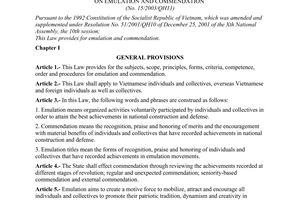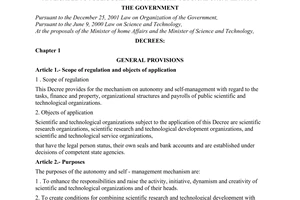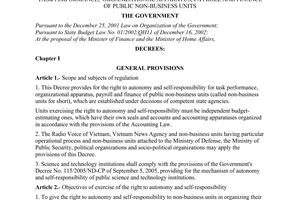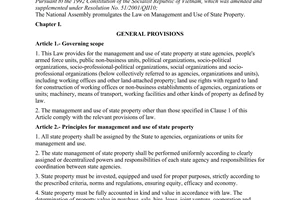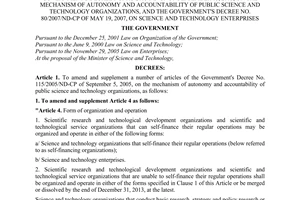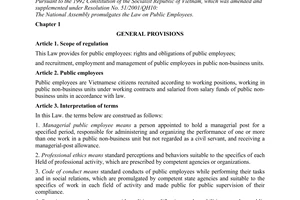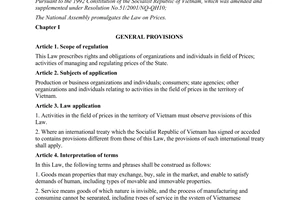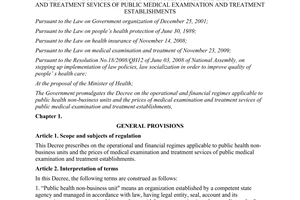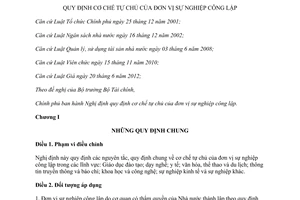Nội dung toàn văn Decree No. 16/2015/ND-CP mechanism exercising the autonomy of Public Administrative Units
|
THE GOVERNMENT |
THE SOCIALIST
REPUBLIC OF VIETNAM |
|
No. 16/2015/NĐ-CP |
Hanoi, February 14, 2015 |
DECREE
STIPULATING THE MECHANISM FOR EXERCISING THE AUTONOMY OF PUBLIC ADMINISTRATIVE UNITS
Pursuant to the Law on Government Organization dated December 25, 2001;
Pursuant to the Law on State Budget dated December 16, 2002;
Pursuant to the Law on Management and Use of State-owned assets dated June 3, 2008;
Pursuant to the Law on Public Officials dated November 15, 2010;
Pursuant to the Law on Price dated June 20, 2012;
After considering the Minister of Finance,
The Government hereby introduces the Decree on stipulating the mechanism for exercising the autonomy of public administrative units.
Chapter I
GENERAL PROVISIONS
Article 1. Scope of application
This Decree sets out general rules and regulations on the mechanism for exercising the autonomy of public administrative units in the following sectors: Education and training; vocational training; culture, sports and tourism; press and media; science and technology; economic and other sectors.
Article 2. Applicable entities
1. Public administrative units established by competent governmental authorities under legal regulations, having the legal status, providing public services or other state management-related services (hereinafter referred to as public administrative unit).
2. Public administrative units affiliated to the Ministry of National Defense, the Ministry of Public Security, political organizations, socio-political organizations as governed by this Decree and other relevant legal regulations.
Article 3. Interpretation of terms
Terms used herein shall be construed as follows:
1. “Autonomy mechanism of public administrative units” refers to a set of regulations on autonomy and responsible autonomy to duty performance, organizational, workforce and finance structure of public administrative units.
2. “Public administrative service” refers to administrative services in such sectors as education and training; vocational training; culture, sports and tourism; press and media; science and technology; economic and other sectors.
3. “Public administrative service funded by the state budget" refers to public administrative services on which all expenses are covered by the Government, or those on which expenses have not been fully included in the service price or fee, or are supported by the state budget.
4. “Public administrative service not funded by the state budget” refers to public administrative services that have more advantages in calling for private-sector involvements, are not subsidized by the Government, and of which the price follows the market mechanism.
Article 4. State management of public administrative service and public administrative units
1. Draw up the legislation on state management of public administrative service and public administrative units; encourage, provide favorable conditions, create the equal and competitive environment in order for organizations or individuals in all economic sectors to get involved in providing public administrative services.
2. Arrange the network of public service units by industries and sectors; compile the list of public services funded by the state budget; issue economic – technical norms that apply to the field of public administrative services managed by the Government; set out regulations on bidding, placement of orders and assignment of duties to supply public administrative services.
3. Set the criteria and standards for the quality of public administrative services; provide the mechanism for supervision, assessment and inspection of the quality of public administrative services and the efficiency in operations of public administrative units.
4. Sketch out the road map for sufficiently calculating prices and fees on public administrative services that public administrative units set and directly pay in favor of persons entitled to state policies.
5. Establish the procedure, process for establishment, reorganization and dissolution, and specify conditions for organization and operation of public administrative units; arrange, transform public administrative units according to the planning approved by competent authorities; delegate the autonomy to affiliated public administrative units.
6. Stipulate transformation of public administrative units into non-public ones or enterprises.
7. Adopt the mechanism and policy to encourage private-sector involvements in public administrative services.
8. Inspect, examine and impose penalties for violations arising in public administrative service supply.
Chapter II
MECHANISM FOR EXERCING THE AUTONOMY OF PUBLIC ADMINISTRATIVE UNITS
Section 1: AUTONOMY TO PERFORM DUTIES AND SET UP ORGANIZATIONAL AND PERSONNEL STRUCTURE
Article 5. Autonomy to perform duties
1. Autonomy to develop plans
Plan to perform duties developed by public administrative units shall be composed of part of the plan to perform tasks that fall within their functions, duties and competence in accordance with laws, and part of the plan to perform their delegated functions and assigned tasks.
a) With regard to public administrative services not funded by the state budget: Public administrative units shall establish their own plan to perform tasks, report to superior regulatory agencies to monitor, inspect and supervise implementation;
b) With regard to public administrative services funded by the state budget: Public administrative units shall establish the plan to perform tasks and report it to superior regulatory agencies to obtain their approval and decision on the method for sending this plan to these public administrative units for implementation.
2. Autonomy to organize duty performance activities
a) Decide on the method for performing duties according to the plan developed by these public administrative units, and the plan assigned by superior regulatory agencies, and ensure the quality and progress of duty performance;
b) Participate in the bidding for supply of public administrative services relevant to the expertise of the public administrative unit designated by competent authorities;
c) Form a joint venture and cooperation with organizations or individuals to render services to meet the social demand in accordance with laws.
Article 6. Autonomy to build the organizational structure
Public administrative units shall be allowed to decide the establishment, restructuring and dissolution of affiliates which do not belong to component units under the decision of competent authorities when conforming to criteria, conditions and standards in accordance with laws; develop the plan to restructure component units for submission to competent authorities for decision.
With regard to public administrative units of which part of its recurrent expenditure is covered by itself and those of which recurrent expenditure is funded by the state budget: They shall set up the plan to arrange and improve the organizational structure for submission to competent authorities for decisions.
Article 7. Autonomy to build the personnel structure
1. Public administrative units shall build the personnel structure by classifying job positions and public servants by professional titles for submission to competent authorities for approval; recruit, use, appoint, discharge, award, punish and manage public servants or employees in accordance with legal regulations; sign employment contracts to hire outside employees to perform their duties.
Public administrative units of which both recurrent and investment expenditures are covered by themselves, and those of which recurrent expenditures are covered by themselves shall decide on the number of employees; public administrative units of which part of recurrent expenditures is covered by themselves shall put forward the proposal for the number of employees working for these units to be submitted to competent authorities for decisions; public administrative units of which recurrent expenditures are funded by the state budget shall submit the proposal for the number of employees on the basis of average manning requirements specified in 05 years ago and equal to not more than the number of employees specified in current manning requirements to competent authorities for decisions (in respect of public administrative units which are newly established and operate within less than 05 years, the number of employees shall conform to the average manning requirements for the whole operation process).
2. In case public administrative units have not yet categorized job positions and public servants by professional titles, and the number of employees determined on the basis of the average manning requirements specified in years ago under the instructions of the Ministry of Home Affairs.
Article 8. Management board
1. Public administrative units of which recurrent and investment expenditures are covered by themselves shall establish the management board to decide important issues during the process of operations of these units.
2. Based on specific conditions, managerial requirements and specialized laws, when necessary, Ministries, ministerial-level agencies and Governmental agencies (hereinafter referred to as Ministries and central organs), the People’s Committees of centrally-affiliated cities or provinces (hereinafter referred to as provincial People’s Committee) shall stipulate the establishment of the management board for public administrative units that are not governed by regulations laid down in Clause 1 of this Article.
3. The management board shall decide on the middle-term and annual strategy and plan of a public administrative unit; decide on the policy on investment in expansion of operations, establish, restructure and dissolve affiliated units; decide on the major policy on organization and personnel (such as appointment, commendation and punishment of public servants; the number of employees, in particular, shall be governed by regulations laid down in Article 7 hereof); approve the regulations on organization and operation of the public administrative unit for the purpose of submitting them to competent authorities for decision; approve annual financial statements, inspect and supervise implementation of the plan, and implement the democratic regulations and make a decision on other key issues of the public administrative unit in accordance with legal regulations.
4. The management board shall be joined by 05 to 11 members; the Chair and members of the management board shall be appointed by competent authorities granting the establishment decision; the management board shall be joined by representatives of the superior regulatory agencies.
5. Procedures for establishment, position, functions, duties, powers, organizational structure and approval for the regulations on operations of the management board in the public administrative unit, relationship of the management board and the head of the public administrative unit with the superior regulatory agency shall conform to instructions of the Ministry of Home Affairs.
Section 2: PUBLIC ADMINISTRATIVE SERVICE PRICE AND CHARGE
Article 9. Public administrative service price and charge
1. Public administrative service price
a) Public administrative services not funded by the state budget
- The public administrative unit shall be allowed to define the public administrative service price according to the market mechanism, decide on receivables, amounts receivable to compensate for reasonable expenditures and ensure accumulated earnings in accordance with legal regulations applied to each sector;
- In particular, such services as medical examination and treatment as well as education and training services at state-owned healthcare, educational and training establishments shall be governed by legal regulations on price.
b) Public administrative services funded by the state budget
- Public administrative service price shall be determined on the basis of economic - technical and cost norms adopted by competent authorities and the roadmap for calculating a full amount of expenses stipulated in Article 10 hereof in which salary costs constituting public administrative service price are calculated by taking into account basic salary level, salary coefficients by payroll, salary grade and title for public administrative units and labor norms introduced by Ministries, central organs and provincial People’s Committees within their jurisdiction;
- Pricing method and competent pricing agencies shall carry out the pricing of public administrative services in accordance with legal regulations on price;
- Within the framework of public administrative service prices stipulated by competent regulatory agencies, public administrative units shall decide on the specific level of price applied to each service type; in case competent regulatory agencies specify the public administrative service price, the public administrative unit shall collect charge at the stipulated price.
2. Public administrative service charge
Public administrative services specified in the list of fees to be collected shall comply with legal regulations on fees and charges. Public administrative units shall be entitled to collect charges according to the charge level stipulated by competent regulatory agencies.
Article 10. Roadmap for pricing public administrative services funded by the state budget
1. Roadmap for pricing public administrative services
a) By 2016: Calculating a full amount of salary costs, direct expenses (managerial and fixed asset depreciation costs have not been included yet);
b) By 2018: Calculating a full amount of salary costs, direct expenses and managerial costs (fixed asset depreciation costs have not been included yet);
c) By 2020: Calculating a full amount of salary costs, direct expenses, managerial and fixed asset depreciation costs.
2. Based on actual conditions, public administrative units shall be allowed to follow the roadmap for public administrative service price as stipulated in Clause 1 of this Article.
3. Ministries, central organs and provincial People’s Committee shall refer to regulations on public administrative service price stipulated in Clause 1 Article 9 hereof, balanced state revenues and expenditures and payment capability of beneficiaries to stipulate the roadmap for calculating public administrative services for submission to authorities having competence in promulgating it, or to promulgate it within their jurisdiction.
Article 11. List of public administrative services funded by the state budget
1. The list of public administrative services funded by the state budget shall be promulgated by regulatory agencies:
a) Ministers, Heads of central organs shall define the list of public administrative services funded by the state budget within their industries or management sectors for submission to the Prime Minister to issue regulations after obtaining opinions from the Ministry of Finance and the Ministry of Planning and Investment;
b) Provincial People’s Committee shall decide the list of public administrative services funded y the state budget within their delegated management (exclusive of the list of public administrative services adopted by the Prime Minister as prescribed in Point a Clause 1 of this Article).
2. Based on the list of public administrative services stipulated in Clause 1 of this Article, Ministries, central organs or provincial People’s Committee shall decide or decentralize inferior agencies to choose which public administrative services will be provided in the form of task assignment, placement of orders or bidding in accordance with applicable regulations.
Section 3: FINANCIAL AUTONOMY
Article 12. Financial autonomy in respect of public administrative units that cover their own recurrent and investment expenses
1. Financing source of a public administrative unit
a) Revenues earned from the rendering of public administrative services, even including the financing from the state budget to place orders to provide public administrative services at the price to which a full amount of costs have been added;
b) Revenues earned by collecting the service charge according to the law on fee or charge and retained for expenditures in accordance with regulations (retained revenues used for recurrent, procurement and major repair of equipment and assets supporting the charge collection);
c) Other earnings according to the legal regulations (if any);
d) Resources derived from the state budget to be allocated to perform non-recurrent tasks (if any), including: Budget for performance of science and technology tasks (applicable to public administrative units which are not scientific and technological organizations); budget for national target programs, other programs and projects; collateral funds for execution of projects in accordance with competent authorities' decisions; investment and development expenditures; budget for procurement of equipment used for administrative operations of projects approved by competent authorities; financing for performance of unscheduled tasks assigned by competent authorities;
dd) Capital sources derived from loans, aids and grants in accordance with laws.
2. Use of financial sources
a) Investment expenses derived from the fund for development of administrative operations, loan capital and other legal financial sources.
- Based on the demand for investment and capability of balancing financial sources, the public administrative unit shall act on its own initiative in establishing the list of investment projects, and report to competent authorities for approval. On the basis of the list of approved investment projects, the public administrative unit shall decide which projects will be financed, including issues related to the construction extent, method, total investment fund, capital source and execution staging in accordance with legal regulations on investment.
- Public administrative units shall be allowed to obtain the Government’s concessional credit loans or interest support for investment projects financed by loans granted by credit institutions in accordance with applicable regulations.
- Based on the demand for development of each public administrative unit, the Government shall consider allocating funds to investment projects in progress and other investment projects in accordance with the decision made by competent authorities.
b) Recurrent expenses: The public administrative unit shall be entitled to use their own initiative in taking advantage of financial sources which the autonomy to use is delegated as stipulated in Point a, Point b (retained revenues used for recurrent expenses) and Point c Clause 1 of this Article for the purpose of recurrent expenses. Several expenses shall be specified as follows:
- Salary expenses: The public administrative unit shall pay salary based on the salary scale, rank and job positions and allowances in accordance with the Governmental regulations that apply to public administrative units. Whenever the Government makes any change to salary, the public administrative unit shall use its own revenues for covering the increased amount of salary (the state budget will not allow supplementary allocation).
- Operating and managerial expenses
As for expenses specified in the spending limits stipulated by competent authorities: Based on the financial capability, the public administrative unit shall be given autonomy to decide the higher or lower amount of expenses compared with limits promulgated by competent authorities and stipulated by the rules and regulations on internal expenses of this unit;
As for expenses not yet specified in the spending limits stipulated by competent authorities: Based on the actual condition, the public administrative unit shall determine the expense level relevant to the rules and regulations on internal expenses and take full responsibilities for their own decisions.
- Depreciation of fixed assets shall comply with regulations. Depreciation of assets established from the state budget’s funding or derived from the state budget shall be recorded into the fund for development of administrative operations.
c) Expenses on non-recurrent tasks: The public administrative unit shall spend in accordance with the law on the state budget and applicable laws on each budget stipulated in Point b (the retained amount used for procurement, major repair of equipment, assets used for collection of service charges), and Point d and Point dd Clause 1 of this Article.
d) The public administrative unit is obliged to comply with the Governmental regulations on spending limits, standards and permitted amount of cars to be used; standards and permitted amount of working accommodations; standards and permitted amount of working phones used at private houses and mobile phones; regulations on overseas business trips; regulations on foreign visitor reception and international conferences organized in Vietnam.
3. Distribution of income generated within a year
a) Annually, after posting all expenses into accounting records, paying taxes and other payables to the state budget (if any) in accordance with regulations, the margin produced due to an amount of revenues higher than an amount of recurrent expenses (if any) shall be used in sequence as follows:
- Set aside 25% used for establishing the fund for development of administrative operations;
- Set aside the fund for supplementation of income: The public administrative unit shall exercise the autonomy to decide on the amount set aside to establish the fund for supplementation of income (the amount set aside is not restricted);
- Set aside the reward fund and the welfare fund of which the maximum amount does not exceed 3-month salary or wage within a year;
- Set aside other funds in accordance with legal regulations;
- The remaining margin generated due to the amount of revenues greater than the amount of expenses (if any) after all funds have been set aside in accordance with regulations shall be added to the fund for development of administrative operations.
b) Use of funds
- The fund for development of administrative operations serves the purpose of investing in development of facilities, purchase working equipment and instruments, improve capability of administrative operations; spend on application of technological and scientific advances, organize professional training for employees, and put investments in joint venture or partnership with domestic and foreign organizations or individuals (applicable to the public administrative unit of which funds conform to regulations) so as to render services relevant to the assigned functions, duties and other expenses (if any).
- The fund for supplementation of income serves the purpose of supplementing incomes of employees within a year and providing provisions for expenditures on supplementation of incomes of employees in the consecutive year in case incomes are reduced.
Spending on supplementation of incomes of employees working for the public administrative unit shall stick to the principle that quantity, quality and efficiency in task performance must be taken into consideration. The maximum increased income coefficient applied to those who hold managerial posts in the public administrative unit shall be twice less than the increased coefficient of realized average income paid to employees working for such unit.
- The reward fund serves the purpose of offering periodic or unplanned rewards to collectives or individuals inside or outside of the public administrative unit (exclusive of the reward policy in accordance with the Law on Competition and Reward) based on the efficiency in task performance and achievements in making contribution to operations of the public administrative unit. The level of reward shall be decided by the head of the public administrative unit in accordance with the rules and regulations on internal expenses of this unit.
- The welfare fund serves the purpose of developing and repairing welfare facilities; spending on operations intended for welfare of the employee collective in the unit; providing subsidies for employees faced with unexpected difficulty, even including those who have retired, or those faced with work incapacity; further spending on severance pays.
c) The specific amount derived from the funds as stipulated in Point a of this Clause and use of the funds shall be decided by the head of the public administrative unit in accordance with the rules and regulations on internal expenses and should be widely disclosed within the unit.
Article 13. Financial autonomy in respect of public administrative units that cover their own recurrent expenses
1. Financing source of a public administrative unit
a) Revenues earned from the rendering of public administrative services, even including the financing from the state budget to place orders to provide public administrative services at the price to which a full amount of costs have been added;
b) Financial sources derived from collected charges according to the law on fee or charge retained for expenditures in accordance with regulations (retained part of financial sources used for recurrent, procurement and major repair of equipment and assets supporting the charge collection);
c) Other earnings according to the legal regulations (if any);
d) Financial sources allocated by the state budget to perform non-recurrent tasks as stipulated in Point d Clause 1 Article 12 hereof (if any);
dd) Capital sources derived from loans, aids and grants in accordance with laws.
2. Use of financial sources:
a) Recurrent expenses: The public administrative unit shall be entitled to use their own initiative in taking advantage of financial sources which the autonomy to use is delegated as stipulated in Point a, Point b (retained finances used for recurrent expenses) and Point c Clause 1 of this Article for the purpose of recurrent expenses in accordance with regulations laid down in Point b Clause 2 Article 12 hereof;
b) Expenses on non-recurrent tasks: The public administrative unit shall spend in accordance with the law on the state budget and applicable laws on each budget stipulated in Point b (the retained amount used for procurement, major repair of equipment, assets used for collection of service charges), and Point d and Point dd Clause 1 of this Article.
3. Distribution of income gained within a year shall conform to regulations laid down in Clause 3 Article 12. In particular, the maximum amount set aside for the fund for supplementation of income shall be restricted to thrice less than the amount used for the fund for salary or wages by salary scale, grade or job positions and other salary allowances stipulated by the Government.
Article 14. Financial autonomy in respect of public administrative units which cover a part of their own recurrent expenses (because the public administrative service price and charge have not been constituted by all costs, or because the Government places orders, assigns tasks to provide public administrative services at the price and charge to which a full amount of costs have not been fully added)
1. Financing source of a public administrative unit
a) Revenues generated by rendering public administrative services;
b) Financial sources derived from collected charges according to the law on fee or charge retained for expenditures in accordance with regulations (retained part of financial sources used for recurrent, procurement and major repair of equipment and assets supporting the charge collection);
c) Financing resources derived from the state budget to support part of expenses which have not been constituted in the public administrative service price and charge;
d) Other earnings according to the legal regulations (if any);
dd) Financial sources allocated by the state budget to perform non-recurrent tasks as stipulated in Point d Clause 1 Article 12 hereof (if any);
e) Capital sources derived from aids and grants in accordance with laws.
2. Use of financing source of a public administrative unit
a) Recurrent expenses: The public administrative unit shall act on their initiative in using financial sources which the autonomy to use is delegated as stipulated in Point a, Point b (retained finances used for recurrent expenses) and Point c and Point d Clause 1 of this Article for the purpose of recurrent expenses. Several expenses shall be specified as follows:
- Salary expenses: The public administrative unit shall pay salary based on the salary scale, rank and job positions and allowances in accordance with the Governmental regulations that apply to public administrative units. Whenever the Government makes any change to salary, the public administrative unit shall use its own finances for covering the increased amount of salary; in case of deficit, the state budget shall give supplementary allocations;
- Operating and managerial expenses: Based on assigned tasks and financial capability, the public administrative unit shall exercise its autonomy to decide the level of recurrent operating and managerial expenses but the amount of these expenses shall be restricted to less than the amount of expenses stipulated by competent authorities.
b) Expenses on non-recurrent tasks: The public administrative unit shall spend in accordance with the law on the state budget and applicable laws on each budget stipulated in Point b (the retained amount used for procurement, major repair of equipment, assets used for collection of service charges), and Point dd and Point e Clause 1 of this Article.
3. Distribution of incomes generated within a year
a) Annually, after posting all expenses into accounting records, paying taxes and other payables to the state budget (if any) in accordance with regulations, the margin produced due to an amount of revenues higher than an amount of recurrent expenses (if any) shall be used in sequence as follows:
- Set aside at least 15% used for establishing the fund for development of administrative operations;
- Set aside the fund for supplementation of income which is restricted to twice less than the amount used for the fund for salary or wages by salary scale, grade or job positions and other salary allowances stipulated by the Government;
- Set aside the reward fund and the welfare fund of which the maximum amount does not exceed 2-month salary or wage that the public administrative has paid for within a year;
- Set aside other funds in accordance with legal regulations;
- The remaining margin generated due to the amount of revenues greater than the amount of expenses (if any) after all funds have been set aside in accordance with regulations shall be added to the fund for development of administrative operations.
If the margin is produced due to the revenues higher than expenses, or once less than the amount provided by the fund for salary or wages by salary scale, grade or job positions realized within a year, the public administrative unit shall exercise its autonomy to use it in sequence as follows: setting aside the fund for supplementation of incomes, the fund for development of administrative operations, the reward fund, the welfare fund and other funds (if any).
b) The specific amount derived from the funds as stipulated in Point a of this Clause and use of the funds shall be decided by the head of the public administrative unit in accordance with the rules and regulations on internal expenses and should be widely disclosed within the unit. Expenses derived from funds shall be governed by Point b Clause 3 Article 12 hereof;
Article 15. Financial autonomy in respect of public administrative units of which recurrent expenses are covered by the Government (applicable to those who act within the functions and tasks assigned by competent authorities, or those who have none of revenues, or those whose revenues are low)
1. Financing source of a public administrative unit
a) The state budget shall pay for recurrent expenses on the basis of the number of employees and the limited amount of distributed budgets approved by competent authorities;
b) Other revenue sources (if any);
c) Financial sources allocated by the state budget to perform non-recurrent tasks as stipulated in Point d Clause 1 Article 12 hereof (if any);
d) Financial sources derived from aids and grants in accordance with laws.
2. Details of expenses in a public administrative unit
a) Recurrent expenses: The public administrative unit shall act on their initiative in using financial sources which the autonomy to use is delegated as stipulated in Point a, Point b Clause 1 of this Article as recurrent expenses. Several expenses shall be specified as follows:
- Salary expenses: The public administrative unit shall pay salary based on the salary scale, rank and job positions and allowances in accordance with the Governmental regulations that apply to public administrative units. Whenever the Government makes any change to salary, the public administrative unit shall use its own finances for covering the increased amount of salary, including use of the supplementary amount distributed by the state budget;
- Operating and managerial expenses: The public administrative unit shall exercise its autonomy to decide the level of expenses but the amount of these expenses shall be restricted to less than the amount of expenses stipulated by competent authorities.
b) Expenses on non-recurrent tasks: The public administrative unit shall spend in accordance with the law on the state budget and applicable laws on each budget stipulated in Point c and Point d Clause 1 of this Article.
3. Use of expenditures saved for recurrent expenses
a) Annually, after settling all expenses, paying taxes and other payables to the state budget (if any) in accordance with regulations, the expenditure saved for recurrent expenses (if any) shall be used in sequence as follows:
- Set aside at least 5% used for establishing the fund for development of administrative operations;
- Set aside the fund for supplementation of income which is restricted to once less than the amount used for the fund for salary or wages by salary scale, grade or job positions and other salary allowances stipulated by the Government;
- Set aside the reward fund and the welfare fund of which the maximum amount does not exceed 1-month realized salary or wage that the public administrative has paid for within a year;
- Set aside other funds in accordance with legal regulations;
If the margin is produced due to the revenues higher than expenses, equal or once less than the amount provided by the fund for salary or wages by salary scale, grade or job positions realized within a year, the public administrative unit shall exercise its autonomy to decide the proper amount set aside for the funds in accordance with the rules and regulations on internal expenses in such unit.
b) The specific amount derived from the funds as stipulated in Point a of this Clause and use of the funds shall be decided by the head of the public administrative unit in accordance with the rules and regulations on internal expenses and should be widely disclosed within the unit. Expenses derived from funds shall be governed by Point b Clause 3 Article 12 hereof;
Article 16. Autonomy to execute financial transactions
1. Opening transaction accounts
a) Public administrative units shall be allowed to open deposit accounts at commercial banks or the State Treasury to reflect operating revenues or expenses generated or incurred from public administrative services not funded by the state budget. Deposit interests shall become the revenue source of this unit and shall be added to the fund for development of administrative operations or to other funds in accordance with laws, but shall not be allowed to be added to the fund for supplementation of income;
b) Finances derived from the state budget, revenues generated from rendering public administrative services funded by the state budget, revenues generated from collection of charges in accordance with the law on fee or charge, the public administrative unit shall open an account at the State Treasury to reflect them.
2. Application for loan capital and capital mobilization
The public administrative unit which provides its services shall be permitted to take out loans granted by credit institutions, mobilize loans from officials or public servants in this unit so as to invest in expansion and improvement of administrative operational quality, and organize relevant service activities that fall within their functions or duties. In particular, the public administrative unit that cover its own recurrent and investment expenses shall be allowed to take out loans and mobilize capital to invest in and develop facilities in accordance with regulations laid down in Point a Clause 2 Article 12 hereof. When applying for loans and mobilizing capital, the public administrative unit must submit the feasible financial plan, take sole responsibility to repay principal and interest in accordance with regulations; assume legal liability for the efficiency in use of loans and capital mobilization.
Article 17. Financial obligations, management of state-owned assets, and rules and regulations of internal expenses of public administrative units
1. Public administrative units that render public services shall be required to apply for registration for service rendering operations, carry out declarations or statements, and pay taxes and other payables to the state budget (if any) in accordance with legal regulations.
2. Public administrative units shall be responsible for managing and using state-owned assets in accordance with legal regulations on management and use of state-owned assets.
3. Public administrative units shall be charged with establishing and introducing the rules and regulations on internal expenses for submission to the superior regulatory agencies. Within a permitted duration of 15 days from receipt of such rules and regulations, if these rules and regulations contain information in breach of the Governmental regulations, the superior regulatory agency shall give written opinions to request these units to revise them to make them become relevant.
Within the abovementioned duration, if the superior regulatory agency has no opinion, the public administrative unit shall implement these rules and regulations, and concurrently send them to the finance body at the same level to monitor or supervise implementation, or to the State Treasury where this unit has opened its transaction account as a basis for the spending control.
Section 4: PREPARING AND COMPLYING WITH BUDGET ESTIMATES
Article 18. Budget estimate preparation
1. Preparation of budget estimates of public administrative units which cover their own recurrent and investment expenses, or those which cover their own recurrent expenses
a) Annually, based on the implementation result in terms of service quantity and volume; conditions of operating revenues and expenses generated and incurred from public administrative services and others in the current year; task requirements specified in the reporting year, the public administrative unit shall draw up the plan on service quantity and volume and prepare the budget estimate for submission to the superior regulatory agency;
b) As for public administrative services ordered by the Government: On a annual basis, based on the quotation and ordered service volume under the instructions of Ministries, central organs and provincial People’s Committee, the public administrative unit shall prepare the budget estimate for submission to the superior regulatory agency in accordance with regulations.
2. The budget estimate of public administrative units which cover part of their own recurrent expenses (because the service price and charge have not been constituted by all costs, or they have to follow orders placed or tasks of providing public services assigned by the Government at the price or charge to which an amount of costs have not been fully added): Based on the task performance in the current year, these public administrative units shall set the plan on the service quantity and volume and estimate revenues or expenses (inclusive of the amount funded by the state budget due to the service price or charge which have not been constituted by all costs) for the purpose of reporting to the superior regulatory agency in accordance with regulations.
3. The budget estimate of public administrative units of which recurrent expenses are covered by the Government (applicable to those that act within their functions or duties delegated or assigned by competent authorities, and those who have no revenue sources, or those whose revenues are low): Based on the task performance in the current year, duties assigned by competent authorities in the planning year, the number of employees approved by competent authorities, the rules and regulations on current expenses, these public administrative units shall prepare their budget estimate for submission to the superior regulatory agency in accordance with applicable regulations.
4. Revenues and expenses shall be estimated in accordance with the law on fee and charge, and non-recurrent tasks shall be governed by regulations laid down in the Law on the State Budget.
5. Annually, based on the budget estimate formulated by public administrative units, the superior regulatory agency shall be responsible for considering and integrating revenues and expenses into the budget estimate for submission to the finance body and other relevant agencies in accordance with the Law on the State Budget.
Article 19. Distribution and allocation of estimated budget
1. The superior regulatory agency’s distribution and allocation of estimated budget to public administrative units shall conform to regulations laid down in the Law on the State Budget.
2. Based on the roadmap for calculating public administrative service price as stipulated in Clause 1 Article 10 hereof, the superior regulatory agency shall carry out placement of orders handled by public administrative units which cover their own recurrent and investment expenses, or those which cover their own recurrent expenses; place orders and allocate state expenditures to public administrative units which cover part of their own recurrent expenses (because the service price and charge have not been constituted by all costs, or they have to follow orders placed or tasks of providing public services assigned by the Government at the price or charge to which an amount of costs have not been fully added).
3. As for public administrative units of which recurrent expenses are covered by the Government (applicable to those who act within the functions and tasks assigned by competent authorities, or those who have none of revenues, or those whose revenues are low): The superior regulatory agency shall allocate estimated budget in a stable manner within a permitted duration of 3 years and shall be allowed to make any change to the estimate whenever the Government changes tasks or policies in accordance with applicable regulations.
Chapter III
IMPLEMENTATION
Article 20. Delegating autonomy to public administrative units
1. Public administrative units shall develop the plan to exercise their autonomy which is relevant to the plan and actual conditions of these units, report to the superior regulatory agency to obtain their approval after receiving written opinions from finance bodies.
2. Delegation of the autonomy and responsible autonomy to public administrative units stipulated in the Chapter II hereof shall be kept unchanged within a permitted duration of 3 years. In case revenue sources or tasks of the public administrative unit has changed and this change is likely to cause any change to the degree of financial autonomy, the public administrative unit shall report to the superior regulatory agency in order for them to consider any adjustment to the degree of autonomy delegated to this unit by the deadline.
Article 21. Contents and requirements enabling public administrative units to adopt the financial mechanism which also applies to enterprises
1. Public administrative units which cover their own recurrent and investment expenses shall be allowed to adopt the financial mechanism which also applies to enterprises (such as single-member limited companies of which 100% of charter capital is held by the State) only if they meet the following requirements:
a) Render public administrative services which have more advantages in calling for private-sector involvements and are not subsidized by the Government;
b) Determine the public service charge by employing the method of full cost pricing (inclusive of depreciation of fixed assets);
c) Have its assets valuated by the Government, and obtain permission from the Government to manage allocated finances in accordance with legal regulations on management and use of state-owned assets;
d) Establish accounting records in accordance with regulations laid down in the generally accepted accounting standards applied to enterprises.
2. Contents in which the corporate-like financial mechanism is applied
a) Be permitted to determine the charter capital and preserve their capital;
b) Be permitted to take out loans, mobilize capital and make outward investments according to legal regulations;
c) Manage, use and set aside an amount of depreciation of fixed assets in accordance with regulations applicable to enterprises;
d) Manage revenues and expenses and distribute profits; implement the accounting and statistical policies in the same manner as an enterprise.
3. Public administrative units are obliged to meet requirements set out in Clause 1 of this Article, develop the project to adopt the corporate-like financial mechanism, and report to Ministries, central organs and local authorities to call for approval under the delegated authority.
Expenses incurred from the formulation of the project and others directly related to application of corporate-like financial mechanism shall be covered by the state budget under the delegated authority.
4. Ministries and central organs shall consider deciding on which affiliated public administrative units are entitled to apply the corporate-like financial mechanism after obtaining written opinions from the Ministry of Finance and provincial People’s Committees (or the inferior regulatory agency within their delegated authority) on considering the decision affiliated public administrative units entitled to apply the corporate-like financial mechanism after written opinions are obtained from local finance organs.
Pursuant to regulations laid down in Clause 1 of this Article, Ministries, central organs and provincial People's Committee within their delegated authority shall direct public administrative units to review and sketch out the roadmap whereby eligible public administrative units will be entitled to apply the corporate-like financial mechanism.
Article 22. Responsibilities of Ministries, central organs and provincial People’s Committees
1. Pursuant to regulations laid down in this Decree:
a) Ministries such as the Ministry of Education and Training, the Ministry of Labor, War Invalids and Social Affairs, the Ministry of Culture, Sports and Tourism, the Ministry of Information and Communications, the Ministry of Health, the Ministry of Science and Technology, shall preside over, cooperate with the Ministry of Finance and the Ministry of Home Affairs as well as other relevant Ministries or agencies in making and requesting the Government to amend and issue the Decree on stipulating the mechanism for exercising the autonomy of public administrative units categorized by specific sectors.
b) The Ministry of Finance shall preside over and collaborate with the Ministry of Home Affairs, other relevant Ministries or organs in making and requesting the Government to introduce the Decree on stipulating the mechanism for exercising the autonomy of public administrative units in the economic administrative sector and others.
2. Ministries, central organs and provincial People’s Committees, depending on scope of their delegated management, functions and assigned duties, shall be permitted to review, amend, supplement or introduce quality criteria, standards, mechanism for supervision, assessment and inspection of public administrative service quality, performance of public administrative units; carry out inspection, examination and handling of violations concerning rendering of public administrative services and organize activities of implementation of other contents relating to responsibilities for state management of public administrative services and public administrative units as stipulated in Article 4 hereof.
3. In 2015, Ministers and Heads of central organs shall assume the following responsibilities:
a) Request the Prime Minister to introduce the planning on networks of public administrative units categorized by industries or sectors, and the list of public administrative services funded by the state budget within their jurisdiction;
b) Introduce economic – technical norms applied to the sector of public administrative services managed by the State within their jurisdiction which serves as the basis for introduction of public administrative service price calculated by applying the full cost pricing method and of the regulations laid down in Article 4 hereof.
4. In 2015, the Ministry of Home Affairs shall be responsible for providing guidance on establishment and operation of the management board; providing guidance on principles and method of determining job positions, and authority, process and procedure for deciding the number of job positions; providing instructions for public administrative units which have not already specified job positions and public servant categorization by professional titles to determine the number of employees on the basis of average manning requirements in the previous year.
5. The Ministry of Finance shall be responsible for changing the method for allocating estimated budgets to public administrative units in relevance to the mechanism for financial autonomy stipulated in this Decree.
6. The Presidents of the provincial People’s Committees shall, within their delegated authority, be responsible for promulgating the followings in 2015: the planning for the network of public administrative units categorized by sectors; the list of public administrative services funded by the state budget; economic - technical norms applied in public administrative service sectors which serves as the basis for introducing public administrative service price by applying the full cost pricing method, and regulations laid down in Article 4 hereof.
Article 23. Responsibilities of Heads of public administrative units
1. Bear responsibility to the direct superior regulatory agency and take legal liability for decisions on exercising autonomy concerning duties, organizational personnel and financial structure of their public administrative units.
2. Ensure that public administrative services meet accepted standards or requirements stipulated by competent authorities.
3. Formulate and implement the rules and regulations on internal expenses, asset use, grassroots-level democracy, financial disclosure and internal audit in accordance with applicable regulations.
4. Organize, manage and use public servants in accordance with laws on public servants.
5. Manage, preserve and develop capital and assets allocated by the State, implement the regulations on accounting, statistics and information, operational reporting and audit in accordance with applicable regulations.
6. Provide competent authorities with the decision on establishment and regulation of functions, duties, powers and organizational structure of the management board in accordance with applicable regulations.
7. Implement regulations on operational disclosure and accountability of their public administrative units in accordance with legal regulations.
Article 24. Effect
1. This Decree shall enter into force since April 6, 2015 and replace the Government’s Decree No. 43/2006/NĐ-CP dated April 25, 2006 on stipulating the autonomy and responsible autonomy to task performance, organizational, personnel and financial structure of public administrative units; serve as the basis for making the Decree on stipulating the mechanism for exercising the autonomy of public administrative units in each sector.
2. While the Decree on stipulating the mechanism for exercising the autonomy of public administrative units categorized by specific sectors in accordance with regulations laid down in Clause 1 of this Article have not been promulgated or amended yet, public administrative units by specific sectors shall be continued to follow the mechanism for exercising the autonomy in accordance with regulations laid down in the Government’s Decree No. 43/2006/NĐ-CP dated April 25, 2006 on stipulating the autonomy, responsible autonomy for task performance, organizational, personnel and financial structure of public administrative units; the Government’s Decree No. 115/2005/NĐ-CP dated May 9, 2005 on stipulating the autonomy, responsible autonomy of public science and technology organizations and the Government’s Decree No. 96/2010/NĐ-CP dated September 20, 2010 on amendments to several articles of the Government’s Decree No. 115/2005/NĐ-CP; the Government’s Decree No. 85/2012/NĐ-CP dated October 15, 2012 on operational and financial mechanism of public administrative units and the price of healthcare services applied to public healthcare establishments.
3. The Ministers, Heads of ministerial-level agencies, Heads of Governmental agencies, and Presidents of People’s Committees of central-affiliated cities and provinces, shall be responsible for implementing this Decree./.
|
|
PP. THE
GOVERNMENT |
------------------------------------------------------------------------------------------------------
This translation is made by LawSoft and
for reference purposes only. Its copyright is owned by LawSoft
and protected under Clause 2, Article 14 of the Law on Intellectual Property.Your comments are always welcomed


